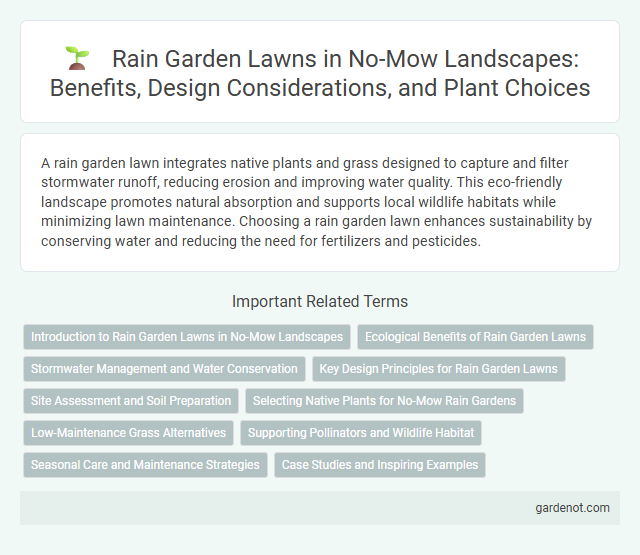A rain garden lawn integrates native plants and grass designed to capture and filter stormwater runoff, reducing erosion and improving water quality. This eco-friendly landscape promotes natural absorption and supports local wildlife habitats while minimizing lawn maintenance. Choosing a rain garden lawn enhances sustainability by conserving water and reducing the need for fertilizers and pesticides.
Introduction to Rain Garden Lawns in No-Mow Landscapes
Rain garden lawns integrate native plants and natural water-absorbing features to minimize irrigation and mowing while enhancing stormwater management. Designed within no-mow landscapes, these lawns filter runoff, reduce soil erosion, and support local ecosystems by creating habitats for pollinators and beneficial insects. Their low-maintenance design promotes sustainability, conserves water, and improves overall lawn health through natural filtration and moisture retention.
Ecological Benefits of Rain Garden Lawns
Rain garden lawns enhance urban biodiversity by providing habitat for native plants and pollinators, improving ecosystem resilience. They effectively manage stormwater runoff, reducing soil erosion and filtering pollutants before water reaches local waterways. These lawns support groundwater recharge and help mitigate urban heat island effects, contributing to healthier and more sustainable environments.
Stormwater Management and Water Conservation
Rain garden lawns enhance stormwater management by capturing and filtering runoff, reducing flooding and water pollution. These lawns promote water conservation by naturally irrigating plants with collected rainwater, minimizing the need for supplemental watering. Implementing rain gardens in no-mow lawns supports sustainable landscapes that improve groundwater recharge and protect local waterways.
Key Design Principles for Rain Garden Lawns
Rain garden lawns maximize stormwater absorption by incorporating native, deep-rooted plants that enhance soil infiltration and reduce runoff. Strategic grading ensures water flows toward the garden basin, preventing erosion and promoting effective water retention. Layered soil structure with compost and sand facilitates optimal drainage while supporting plant health in rain garden settings.
Site Assessment and Soil Preparation
Rain garden lawns require an initial site assessment to identify low-lying areas with proper drainage characteristics that can collect and absorb stormwater effectively. Soil preparation involves amending compacted or clay-heavy soils with organic matter to enhance permeability and support native plant growth. Properly prepared soils prevent runoff, promote groundwater recharge, and optimize rain garden lawn sustainability.
Selecting Native Plants for No-Mow Rain Gardens
Selecting native plants for no-mow rain gardens enhances water absorption and supports local ecosystems by reducing maintenance and irrigation needs. Species like Black-eyed Susan, Switchgrass, and Blue Flag Iris thrive in rain gardens, offering deep root systems that improve soil structure and filter pollutants. Using drought-resistant natives ensures sustainability while attracting pollinators and beneficial wildlife to the no-mow lawn environment.
Low-Maintenance Grass Alternatives
Rain garden lawns offer an eco-friendly low-maintenance grass alternative by incorporating native plants and grasses that naturally filter stormwater, reducing runoff and improving soil health. These designs rely on drought-tolerant species like buffalo grass and fescue, which require minimal mowing, watering, and fertilization compared to traditional turf. Implementing rain garden lawns can significantly lower landscaping costs and environmental impact while supporting local biodiversity.
Supporting Pollinators and Wildlife Habitat
Rain garden lawns create a thriving ecosystem by integrating native plants that support pollinators such as bees, butterflies, and hummingbirds. These specialized lawns enhance biodiversity and provide essential habitats for various wildlife while naturally managing stormwater runoff. Incorporating rain garden lawns into no-mow landscaping reduces maintenance and promotes ecological balance.
Seasonal Care and Maintenance Strategies
Rain garden lawns require seasonal care to ensure optimal water absorption and plant health, including regular removal of invasive weeds and mulching in spring to retain moisture. During dry summer months, deep and infrequent watering promotes deep root growth, while fall maintenance involves pruning and clearing debris to prepare for dormancy. Winter care focuses on avoiding soil compaction and protecting roots from harsh conditions, supporting a resilient and sustainable rain garden ecosystem year-round.
Case Studies and Inspiring Examples
Rain garden lawns demonstrate effective stormwater management by capturing and filtering runoff, reducing erosion and improving local water quality. Case studies from urban landscapes in Portland and Seattle highlight significant ecological benefits, including increased biodiversity and pollutant removal. Inspiring examples showcase integration with native plants, creating no-mow lawns that require minimal maintenance while enhancing neighborhood green spaces.
Rain garden lawn Infographic

 gardenot.com
gardenot.com